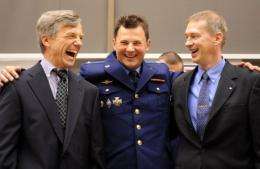New dinner table top priority as ISS expands

Astronauts set to blast off for the International Space Station said Thursday that constructing a new dinner table would be a top priority as its permanent crew expands to six.
The three-man crew will travel into orbit on a Soyuz capsule later this month, joining an existing three-person team on the ISS and for the first time raising its permanent crew to six.
"We are now going to have six people in orbit, with our arrival we will for the first time be six. So we will need to engineer another table, so we can all eat and chat together," Russian cosmonaut Roman Romanenko said.
"Lunch is a ritual process in orbit," he told journalists at Star City, the Russian training center outside Moscow for the Soyuz space flights.
Romanenko will be joined by Belgian astronaut Frank De Winne and Canadian scientist Robert Thirsk to form the first six-man crew in orbit when they blast off from Russia's Baikonur Cosmodrome in the Kazakh steppes on May 27.
This Soyuz mission will also be the first time astronauts from all five of the partners in the ISS -- Canada, the European Space Agency (ESA), Japan, Russia and United States -- are in orbit together.
For his part, Thirsk said he would contribute some Canadian specialties to the crew's menu including Caribou meat and Arctic Char, a freshwater fish, but he said he most looked forward to the Russian dishes onboard.
"I love Russian food and I hope it will make up 50 percent of my rations," he enthused.
Overall, De Winne said the larger crew would ease the pace of work and make for a less hectic rotation of space residents.
"We usually have to rush to do everything for the switch over in 10 days, but this time it's all ready. We have a lot of time," De Winne said. "The crew onboard will have time to show us everything over the course of four months."
Housing six astronauts in orbit has become possible as construction of the ISS nears completion after its start 10 years ago.
But even as the six-person ISS crew plan to put the finishing touches on their orbiting home, international space agencies are looking toward the next step in space exploration: travel to Mars.
Experiments planned by Thirsk aim to calculate the human risks of longer residence in space with a mind to the next generation of long-haul space travel.
This is "science that is aimed at allowing future astronauts to venture further into space," Thirsk said, saying he would run experiments on the effects of near-weightlessness on conceptions of space and bodily function.
"We will also be examining the effects of radiation on future astronauts to Mars," he added.
In one study, Thirsk will himself be taking medication usually prescribed to geriatric patients to counter the effects of bone loss in space.
"Astronauts have the best job in the world, but there is always a cost associated with going to space," Thirsk said.
But in the face of such costs, he added, the discomfort of a few days of so-called motion sickness sustained by astronauts during their first days in orbit could easily be shrugged off.
"We don't usually talk about our susceptibility to motion sickness, it's only a small problem," he said.
(c) 2009 AFP

















